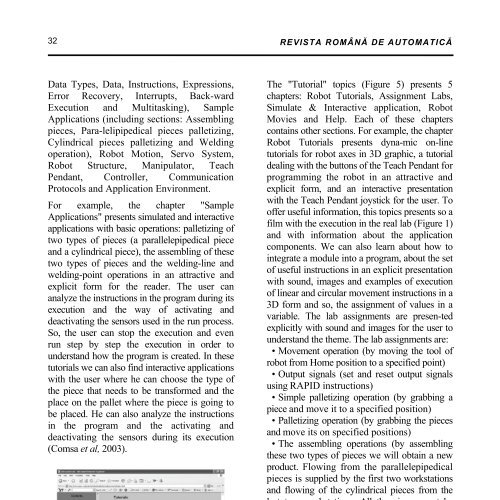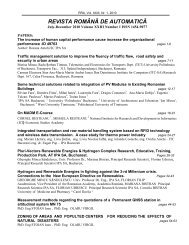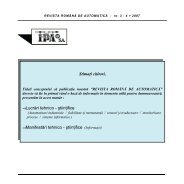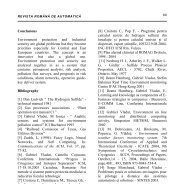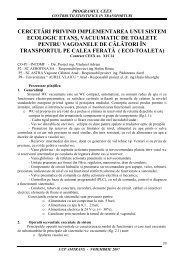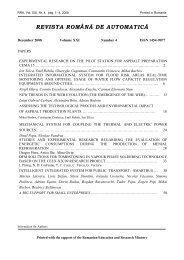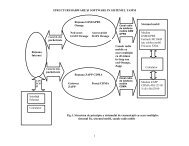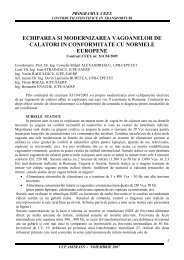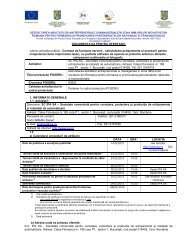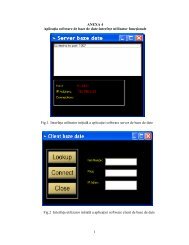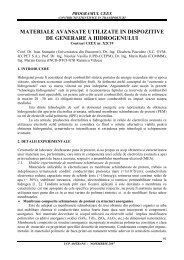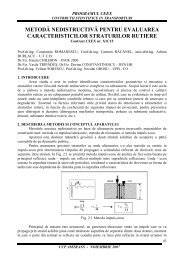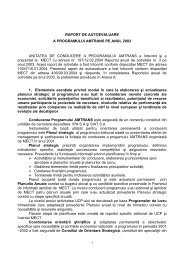Part II - IPA SA
Part II - IPA SA
Part II - IPA SA
Create successful ePaper yourself
Turn your PDF publications into a flip-book with our unique Google optimized e-Paper software.
32 REVISTA ROMÂN DE AUTOMATIC<br />
Data Types, Data, Instructions, Expressions,<br />
Error Recovery, Interrupts, Back-ward<br />
Execution and Multitasking), Sample<br />
Applications (including sections: Assembling<br />
pieces, Para-lelipipedical pieces palletizing,<br />
Cylindrical pieces palletizing and Welding<br />
operation), Robot Motion, Servo System,<br />
Robot Structure, Manipulator, Teach<br />
Pendant, Controller, Communication<br />
Protocols and Application Environment.<br />
For example, the chapter "Sample<br />
Applications" presents simulated and interactive<br />
applications with basic operations: palletizing of<br />
two types of pieces (a parallelepipedical piece<br />
and a cylindrical piece), the assembling of these<br />
two types of pieces and the welding-line and<br />
welding-point operations in an attractive and<br />
explicit form for the reader. The user can<br />
analyze the instructions in the program during its<br />
execution and the way of activating and<br />
deactivating the sensors used in the run process.<br />
So, the user can stop the execution and even<br />
run step by step the execution in order to<br />
understand how the program is created. In these<br />
tutorials we can also find interactive applications<br />
with the user where he can choose the type of<br />
the piece that needs to be transformed and the<br />
place on the pallet where the piece is going to<br />
be placed. He can also analyze the instructions<br />
in the program and the activating and<br />
deactivating the sensors during its execution<br />
(Comsa et al, 2003).<br />
Fig. 5 The GUI interface for the topics “Tutorial”<br />
The "Tutorial" topics (Figure 5) presents 5<br />
chapters: Robot Tutorials, Assignment Labs,<br />
Simulate & Interactive application, Robot<br />
Movies and Help. Each of these chapters<br />
contains other sections. For example, the chapter<br />
Robot Tutorials presents dyna-mic on-line<br />
tutorials for robot axes in 3D graphic, a tutorial<br />
dealing with the buttons of the Teach Pendant for<br />
programming the robot in an attractive and<br />
explicit form, and an interactive presentation<br />
with the Teach Pendant joystick for the user. To<br />
offer useful information, this topics presents so a<br />
film with the execution in the real lab (Figure 1)<br />
and with information about the application<br />
components. We can also learn about how to<br />
integrate a module into a program, about the set<br />
of useful instructions in an explicit presentation<br />
with sound, images and examples of execution<br />
of linear and circular movement instructions in a<br />
3D form and so, the assignment of values in a<br />
variable. The lab assignments are presen-ted<br />
explicitly with sound and images for the user to<br />
understand the theme. The lab assignments are:<br />
• Movement operation (by moving the tool of<br />
robot from Home position to a specified point)<br />
• Output signals (set and reset output signals<br />
using RAPID instructions)<br />
• Simple palletizing operation (by grabbing a<br />
piece and move it to a specified position)<br />
• Palletizing operation (by grabbing the pieces<br />
and move its on specified positions)<br />
• The assembling operations (by assembling<br />
these two types of pieces we will obtain a new<br />
product. Flowing from the parallelepipedical<br />
pieces is supplied by the first two workstations<br />
and flowing of the cylindrical pieces from the<br />
last two workstations. All the pieces must be<br />
placed in specific positions, knowns by the<br />
robot. This two types of pieces are taken one by<br />
one by the robot and placed into the assembling<br />
place. Because of position's errors, it's<br />
necessary for the robot to do two supplementary<br />
movements to arrange all the pieces on the<br />
assembling place. After that, the robot puts the<br />
new product in a matricial storehouse with four<br />
locations.<br />
• The palletizing operation of<br />
parallelepipedical pieces (all the pieces must<br />
be placed successively in a matricial<br />
storehouse with four locations).


